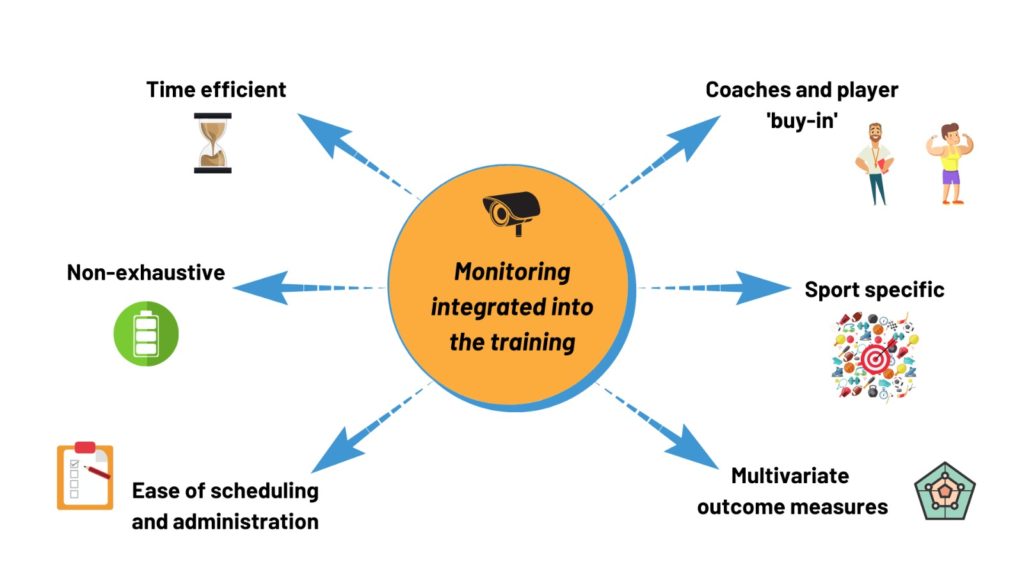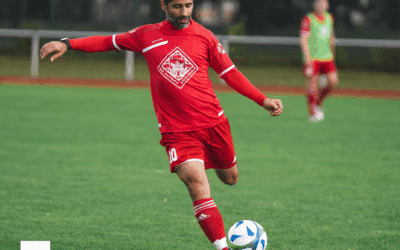Background
Gaining understanding on how an athlete responds to the training plan is a major quest for all staff members (coaching, performance and medical staff) working in elite team-sports (11,12). Accordingly, it is common that practitioners collect data on a daily basis, including different load variables imposed on the athletes during the training or competition (usually referred to as the training dose), and also information collected during and outside the actual training as indicators of training responses (10).This knowledge can assist practitioners to understand changes in performance, reflect on previous training, and facilitate future prescription (10,11).Monitoring training responses in a team environment is challenging for many reasons, including:
- the time required to administer testing protocols in a large number of individuals,
- exposing the athletes to unnecessary loads which may elicit excessive fatigue,
- or other reasons related to human resources and coach or player buy-in (5).
Such examples can provide viable alternatives for observing athlete’s responses while eliminating some of the challenges associated with testing in team-sports (Figure 1).This has previously been termed ‘invisible monitoring’ by Jace Delaney (6).

Figure 1. The challenges associated with testing in team-sports.
Whilst the aforementioned examples may include many variations of exercise protocols, their implementation shares similar ideas and objectives, including:- The ability to administer with the purpose of better understanding how the athletes respond to training (i.e. the interaction of fitness–fatigue status),
- Using short, standardised exercise activities. Certainly, the term “standardised” is quite broad and perhaps warrants further discussions, particularly around the degree of standardisation in generic activities like fixed overground runs versus game-based exercises such as small-sided games,
- Not exposing the athletes to prolonged-maximal or exhausting intensities that result in negative effects on subsequent training, effects on subsequent training. Or alternatively do not elicit excessive training stimulus beyond that originally intended, and
- Involving various training response measures that can be objective (e.g., heart rate, total/threshold-specific distance covered) or subjective (e.g. perceived exertion).
We found a large number of SMFT publications in the team-sports literature (78 studies), with the majority were published over the recent years.We identified many variations of SMFT (>40 unique protocols) utilizing different exercise regimen (continuous versus intermittent) (8,16) and activity modes (running versus cycling) (16,17) that have been administered across a range of durations and intensities (Figure 2). In addition, numerous outcome measures such as HR-derived (3), blood (9), perceptual (4), and GPS (15) or accelerometer-derived (1) indices are commonly collected.

Figure 2. Variations of SMFT utilizing different exercise regimen.
However, an audit of the published research does not necessarily reflect applied practice (2,5), and in order to inform the most pertinent research questions and experimental features that can facilitate translation to industry practice, further information from our performance community is needed.For this reason, we created an online survey that aims to gain insight into the use of SMFT in team-sports and we would like you to participate (see below for more information).We expect that this project will have an impact on both practitioners and researchers via showcasing the current methodological frameworks, practices and challenges surrounding the applications of SMFT in team-sport settings. Herein, we seek your help!
Take the survey here
About the survey
To participate in the survey, you must be:- >18 years old.
- A team-sport practitioner (e.g. sport scientist, strength & conditioning coach, medical staff).
- Currently working or have worked in a team competes in elite, professional or semi-professional level.
- Currently using or have used in the past submaximal fitness tests in the form of running, cycling exercises and/or standardised drills (refer to Figure 2) as part of a monitoring system.
- one of four (4) of single sport HIIT Science training courses (valued at >$100). Winners can choose from one of our 20 different sports.
- PlayerMaker UNO wearable tracker unit (valued at $345 AUD).
- A variety of Sport Sciences and Conditioning textbooks: ‘Science and Application High-Intensity Training: Solutions to The Programming Puzzle’, ‘High-Performance Training for Sport’ (New Edition) and ‘NSCA’s Essentials for Sport Sciences’.
Take the survey here
P.S. Please be assured that your contact details will be recorded using a separate platform from the survey, hence your survey responses will remain anonymous. We will include you in the raffle only if you wish. Further details will be provided at the end of the survey.About the author
Tzlil is a sport scientist and strength & conditioning coach currently doing a PhD in Human Performance Science and Sport Analytics at Western Sydney University. In his PhD Tzlil examines the use of Submaximal Fitness Tests as indicators of fitness–fatigue status in team-sports. Prior to that he completed a bachelor’s degree in exercise science and physical education at Wingate college in Israel and master’s degree in strength and conditioning at UCAM University in Spain. Tzlil has worked for a number of elite team-sport organisations, including Macabbi Tel-Aviv FC and Wingate girls basketball academy, and currently work and consult for a variety of professional teams and individual athletes. Follow Tzlil on Twitter: @shushan_tzlil, or find more about his research at ResearchGate.
and strength & conditioning coach currently doing a PhD in Human Performance Science and Sport Analytics at Western Sydney University. In his PhD Tzlil examines the use of Submaximal Fitness Tests as indicators of fitness–fatigue status in team-sports. Prior to that he completed a bachelor’s degree in exercise science and physical education at Wingate college in Israel and master’s degree in strength and conditioning at UCAM University in Spain. Tzlil has worked for a number of elite team-sport organisations, including Macabbi Tel-Aviv FC and Wingate girls basketball academy, and currently work and consult for a variety of professional teams and individual athletes. Follow Tzlil on Twitter: @shushan_tzlil, or find more about his research at ResearchGate.
References
- Buchheit, M, Lacome, M, Cholley, Y, and Simpson, BM. Neuromuscular Responses to Conditioned Soccer Sessions Assessed via GPS-Embedded Accelerometers: Insights Into Tactical Periodization. International Journal of Sports Physiology and Performance 13: 577–583, 2018. 1123/ijspp.2017-0045
- Buchheit, M, McHugh, D, and Smith, S. Kitman Labs Performance Intelligence Research Initiative: A Survey to bring research on the field. Sport Perf Sci & Reports 1, 2021. Link
- Buchheit, M, Mendez-Villanueva, A, Quod, MJ, Poulos, N, and Bourdon, P. Determinants of the variability of heart rate measures during a competitive period in young soccer players. Eur J Appl Physiol 109: 869–878, 2010. https://doi.org/10.1007/s00421-010-1422-x
- Buchheit, M, Voss, SC, Nybo, L, Mohr, M, and Racinais, S. Physiological and performance adaptations to an in-season soccer camp in the heat: Associations with heart rate and heart rate variability: Monitoring responses to training in the heat. Scandinavian Journal of Medicine & Science in Sports 21: e477–e485, 2011. 1111/j.1600-0838.2011.01378.x
- Carling, C, Lacome, M, McCall, A, Dupont, G, Le Gall, F, Simpson, B, et al. Monitoring of Post-match Fatigue in Professional Soccer: Welcome to the Real World. Sports Med 48: 2695–2702, 2018. 1007/s40279-018-0935-z
- Delaney, J. (2018, August 9). The paradox of “invisible” monitoring: The less you do, the more you do! HIIT Science Blog. Link
- Dello Iacono, A, Unnithan, V, Shushan, T, King, M, and Beato, M. Training load responses to football game profile-based training (GPBT) formats: effects of locomotive demands manipulation. bs, 2020. https://doi.org/10.5114/biolsport.2021.102919
- Hulin, BT, Gabbett, TJ, Johnston, RD, and Jenkins, DG. Sub-maximal heart rate is associated with changes in high-intensity intermittent running ability in professional rugby league players. Science and Medicine in Football 3: 50–56, 2019. https://doi.org/10.1080/24733938.2018.1475748
- Iaia, FM, Fiorenza, M, Larghi, L, Alberti, G, Millet, GP, and Girard, O. Short- or long-rest intervals during repeated-sprint training in soccer? PLoS ONE 12: e0171462, 2017. https://doi.org/10.1371/journal.pone.0171462
- I Impellizzeri, FM, Marcora, SM, and Coutts, AJ. Internal and External Training Load: 15 Years On. International Journal of Sports Physiology and Performance 14: 270–273, 2019. 1123/ijspp.2018-0935
- Impellizzeri, F. M., Menaspà, P., Coutts, A. J., Kalkhoven, J., & Menaspà, M. J. (2020). Training Load and Its Role in Injury Prevention, Part I: Back to the Future. Journal of Athletic Training, 55(9), 885–892. 4085/1062-6050-500-19
- Lacome, M, Simpson, BM, and Buchheit, M. Monitoring Training Status With Player-Tracking Technology: Still on The Road to Rome. Aspetar Sports Med Journal 7: 54–63, 2018. Link
- Leduc, C, Tee, J, Lacome, M, Weakley, J, Cheradame, J, Ramirez, C, et al. Convergent Validity, Reliability, and Sensitivity of a Running Test to Monitor Neuromuscular Fatigue. International Journal of Sports Physiology and Performance 15: 1067–1073, 2020. 1123/ijspp.2019-0319
- Owen, AL, Newton, M, Shovlin, A, and Malone, S. The Use of Small-Sided Games as an Aerobic Fitness Assessment Supplement within Elite Level Professional Soccer. Journal of Human Kinetics 71: 243–253, 2020. 2478/hukin-2019-0086
- Rowell, AE, Aughey, RJ, Clubb, J, and Cormack, SJ. A Standardized Small Sided Game Can Be Used to Monitor Neuromuscular Fatigue in Professional A-League Football Players. Front Physiol 9: 1011, 2018. 3389/fphys.2018.01011
- Scott, TJ, McLaren, SJ, Caia, J, and Kelly, VG. The reliability and usefulness of an individualised submaximal shuttle run test in elite rugby league players. Science and Medicine in Football 2: 184–190, 2018. https://doi.org/10.1080/24733938.2018.1448937
- Thorpe, RT, Strudwick, AJ, Buchheit, M, Atkinson, G, Drust, B, and Gregson, W. Tracking Morning Fatigue Status Across In-Season Training Weeks in Elite Soccer Players. International Journal of Sports Physiology and Performance 11: 947–952, 2016. 1123/ijspp.2015-0490






